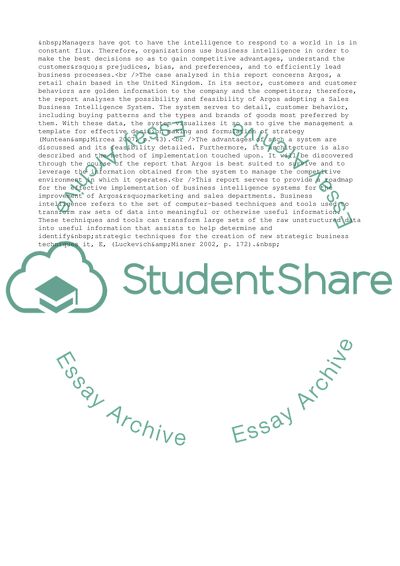Cite this document
(Business Intelligence Solutions for the Improvement of Argos Sales Coursework Example | Topics and Well Written Essays - 2000 words, n.d.)
Business Intelligence Solutions for the Improvement of Argos Sales Coursework Example | Topics and Well Written Essays - 2000 words. https://studentshare.org/business/1874338-how-the-deployment-of-appropriate-business-intelligence-solutions-could-enhance-decision-support-performance-reporting-and-control-for-argos
Business Intelligence Solutions for the Improvement of Argos Sales Coursework Example | Topics and Well Written Essays - 2000 words. https://studentshare.org/business/1874338-how-the-deployment-of-appropriate-business-intelligence-solutions-could-enhance-decision-support-performance-reporting-and-control-for-argos
(Business Intelligence Solutions for the Improvement of Argos Sales Coursework Example | Topics and Well Written Essays - 2000 Words)
Business Intelligence Solutions for the Improvement of Argos Sales Coursework Example | Topics and Well Written Essays - 2000 Words. https://studentshare.org/business/1874338-how-the-deployment-of-appropriate-business-intelligence-solutions-could-enhance-decision-support-performance-reporting-and-control-for-argos.
Business Intelligence Solutions for the Improvement of Argos Sales Coursework Example | Topics and Well Written Essays - 2000 Words. https://studentshare.org/business/1874338-how-the-deployment-of-appropriate-business-intelligence-solutions-could-enhance-decision-support-performance-reporting-and-control-for-argos.
“Business Intelligence Solutions for the Improvement of Argos Sales Coursework Example | Topics and Well Written Essays - 2000 Words”. https://studentshare.org/business/1874338-how-the-deployment-of-appropriate-business-intelligence-solutions-could-enhance-decision-support-performance-reporting-and-control-for-argos.


